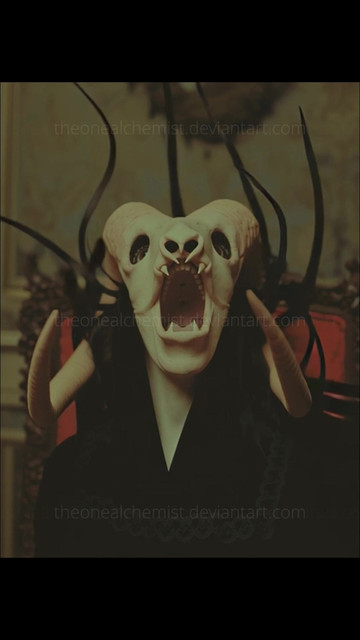HOME | DD
 Opergeist — Mephistopheles I
Opergeist — Mephistopheles I

Published: 2011-05-09 01:46:21 +0000 UTC; Views: 2099; Favourites: 18; Downloads: 67
Redirect to original
Description
Eric Watkins Modeling the Construction aspect of my Master of Fine Arts Thesis project.Mephistopheles from 'Faust' by Charles Gounod, presented as a Brechtian Production set in an abandoned 19th century Theatre. Design, Construction and Photography by me.
Fabrics present are:
black distressed denim
red distressed denim
Custom dyed fur collar
red and black lambskin
topstitched and razor cut red cowhide
Related content
Comments: 8

This looks awesome. Have you seen Svankmayer's (sp) Faust, that would be interesting. But also that you took it specifically from a Brecht point of view, I am not expert on the matter of him but how much did that influence the this? Or what is a provocation that was simply given?
Sorry, I am just really interested in costume design, and it not just illustrating a character and look simply, but rather making a gesture towards an idea or serving a function. Which sounds rather wankey sorry.
👍: 0 ⏩: 1

I have, in fact. It was certainly an interesting vision of Dr. Faustus.
Brecht and his Production Designer Caspar Neher felt that design should speak to the essence of a piece and not the trappings of doing theatre.
So, I chose to do this opera because it is traditionally produced as a very lavish, heavily costumed piece and boiled it down to its stylistic bare bones, discovering what I needed to tell the story. In this case, that meant that the characters were not striving for any kind of realism, but rather acknowledging that they are characters and not actually demons or angels.
The music has so much power, darkness and romance that it needn't have a huge realistic set or period costumes to really relate to a modern audience.
I could talk about this for hours, sorry for the long message.
👍: 0 ⏩: 1

Hey, go on talk. I dare you too, if anything I should apologise for asking so many questions. I'm also in my last year of design, and am working on my Major, which is the Costume design of a Jacobian play. So not only am I really interested in learning dif interperations of a directors work, but also dif approches to costume and teaching it.
Was it a design and make of just one character, or did you look at others as well to inform Mephistopheles? Because yea, it all boils down to actors playing roles. But there are so many different ways to acknowledge that, by going overtly theatrical, or going the complete opposite. There's a trend where I study to acknowledge the unseen elements such as the technicians whilst having outlandish costumes. I guess I need to go and research Brecht more before I open my mouth. I'm not trying to critique, I'm just interested in what you've done, but more so how you've done it, and you don't need to pay any attention to that if you don't want too.
Because what I find interesting is that they are characters in an opera. But in that opera and story they have the role of angels and demons, they are a different class to the 'humans', and that you've boiled it down to bare bones. They still have a distinct purpose and role in the production to be angels and demons. I suppose it is not trying to fool the audience into believing this... but it would be kinda cool to go overtly demon-like and 'fool the characters', letting the audience in on the joke.
I like it, simply because I guess for one I don't totally understand it. It is very 'you' (from what I've seen of your work), how the devil would look if walking around in a steampunk version of the opera. Reminds me of the ice-hockey kids in Dogma, you instantly get that evil, melicous feel. Its the colours and textures that do that, and the red on the fur is kinda, y'know animalistic. I can imagine under the right kind of lighting that red would literally 'pop' whilst the rest could happily disappear.
The bit I don't understand, and it would be because I am seeing this on its own, and not in a full mounted production, is what is the bare-bones you boiled it down too? Yea, I see and agree about stripping it down from the lavish period, but Opera's and Shakespeare's are often done that way now so as 'set' and costume become ways in for the audience. But how do you see it relating? I'm having problems with this in my own work, simply because the director has decided to keep it period (not strictly), but its a struggle of finding that balance between helping an audience understand through a Jacobian lens, or what the costume keeps from the period or doesn't.
Sorry, these are just questions that are huge and looming for me at the moment as well, and I am by no means any closer to answering them. But yea, fresh approches are gold to me atm. As I said, am not trying to critic, just open discussion? I wrote heaps, and heaps, and prob waffled some garbage. Do feel free to tell me to shut up if you don't want to talk, because our processes and approches to theatricial design are prob very dif XD
👍: 0 ⏩: 1

Damn, that was really very long. Sorry. Procastination is a great and at the same time weak sword.
👍: 0 ⏩: 0























